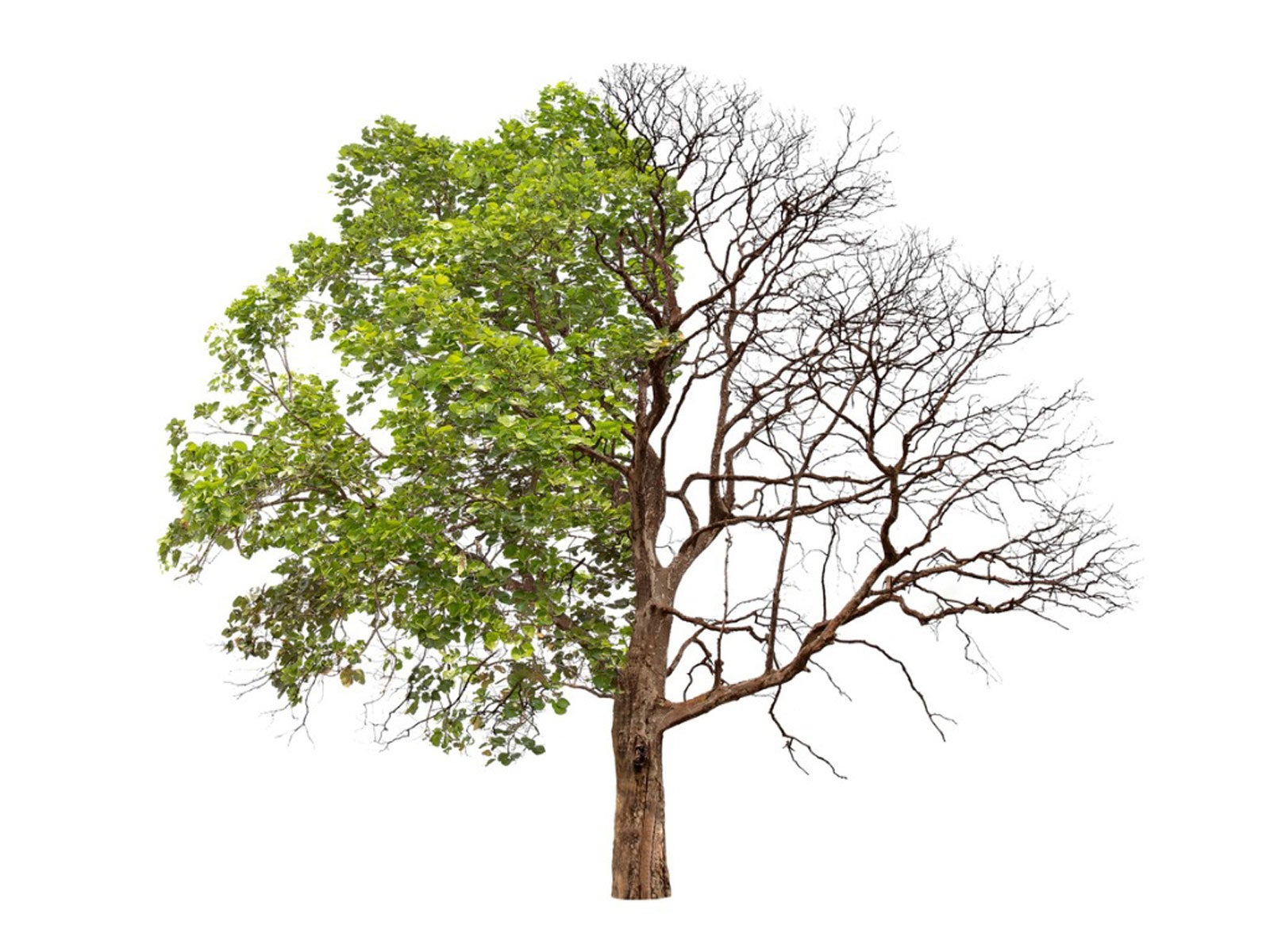Tree Is Dead On One Side – What Causes A Half Dead Tree


If a backyard tree dies, the mourning gardener knows they must remove it. What about when the tree is dead on one side only? If your tree has leaves on one side, you’ll first want to figure out what is going on with it.
While a half dead tree might be suffering from a variety of conditions, the odds are that the tree has one of several serious root issues. Read on for more information.
Why One Side of Tree is Dead
Insect pests can cause serious damage to trees, but they rarely limit their attack to one side of a tree. Similarly, foliage diseases tend to damage or destroy the entire canopy of a tree rather than only half of it. When you see that a tree has leaves on one side only, it is not likely to be an insect pest or leaf disease. The exception might be a tree near a border wall or fence where its canopy can be eaten on one side by deer or livestock.
When you see that a tree is dead on one side, with limbs and leaves dying, it may be time to call in a specialist. You are likely looking at a root problem. This can be caused by a “girdling root,” a root that is wrapped very tightly around the trunk below the soil line.
A girdling root cuts off the flow of water and nutrients from the roots to the branches. If this happens on one side of the tree, one half of the tree dies back, and the tree looks half dead. An arborist can remove some of the soil around the tree’s roots to see if this is your problem. If so, it may be possible to cut the root during the dormant season.
Other Causes for Half Dead Tree
There are several types of fungi that can cause one side of a tree to look dead. The most prevalent are phytophthora root rot and verticillium wilt. These are pathogens that live in the soil and affect the movement of water and nutrients.
These fungi can cause a decline or even the death of the tree. Phytophthora root rot appears largely in poorly drained soils and causes dark, water-soaked spots or cankers on the trunk. Verticillium wilt usually affects branches on only one side of the tree, causing yellowing leaves and dead branches.
Gardening tips, videos, info and more delivered right to your inbox!
Sign up for the Gardening Know How newsletter today and receive a free copy of our e-book "How to Grow Delicious Tomatoes".

Teo Spengler is a master gardener and a docent at the San Francisco Botanical Garden, where she hosts public tours. She has studied horticulture and written about nature, trees, plants, and gardening for more than two decades. Her extended family includes some 30 houseplants and hundreds of outdoor plants, including 250 trees, which are her main passion. Spengler currently splits her life between San Francisco and the French Basque Country, though she was raised in Alaska, giving her experience of gardening in a range of climates.
-
 Zinnias On Repeat: 10 Glorious Cut-And-Come-Again Varieties For Endless Summer Bouquets
Zinnias On Repeat: 10 Glorious Cut-And-Come-Again Varieties For Endless Summer BouquetsThese zinnia varieties keep giving all summer, making them the perfect choice for dedicated cutting gardens – or just the occasional homegrown bouquet.
By Ellen Wells
-
 Create A Romantic Garden Straight Out Of Bridgerton: Regency Era Romance In Your Garden
Create A Romantic Garden Straight Out Of Bridgerton: Regency Era Romance In Your GardenTry some romantic garden ideas straight out of Bridgerton. Flowers and gardens in the Regency era were lush and charming and you can get the same look!
By Bonnie L. Grant
-
 Best Trees For Carbon Sequestration And Climate Change
Best Trees For Carbon Sequestration And Climate ChangeLet’s keep planting trees. They are our best bet for capturing carbon and may help with our global warming issues.
By Teo Spengler
-
 7 Invasive Trees You Should Never Plant In Your Yard Or Garden
7 Invasive Trees You Should Never Plant In Your Yard Or GardenWhat are some invasive trees you should never plant in your yard? Click here to find out.
By Teo Spengler
-
 How Close Can You Plant A Tree To A Stump?
How Close Can You Plant A Tree To A Stump?Looking to plant new trees near old stumps or where stumps have been removed? Click here to learn how.
By Teo Spengler
-
 Messiest Trees That Drop Debris Everywhere
Messiest Trees That Drop Debris EverywhereWant to know which trees will create the biggest messes in your home landscape? Click here to find out.
By Amy Grant
-
 How To Get Rid Of Tree Sprouts In The Yard From Nearby Trees
How To Get Rid Of Tree Sprouts In The Yard From Nearby TreesLearn the simple way to keep pesky tree seedlings in your lawn from becoming saplings.
By Teo Spengler
-
 How To Tell How Old A Tree Is
How To Tell How Old A Tree IsEver wondered how to calculate the age of a tree? Click here to learn all about it.
By Teo Spengler
-
 When To Remove Tree Stakes From Saplings
When To Remove Tree Stakes From SaplingsA newly planted tree may grow strong when it’s staked, but don’t forget to remove the stakes when it’s stable.
By Teo Spengler
-
 Inosculation And Trees Growing Together
Inosculation And Trees Growing TogetherIf you ever see two trees that have bonded and grown together, read here to learn why and how it happens.
By Teo Spengler